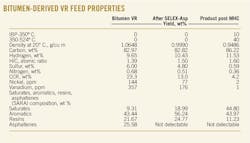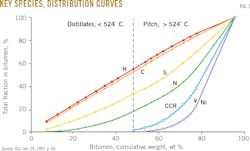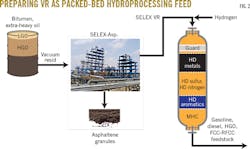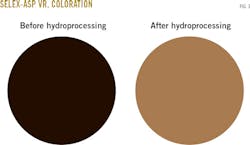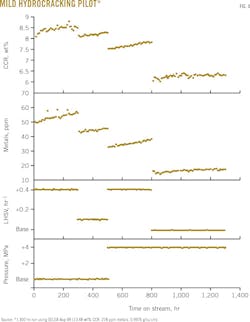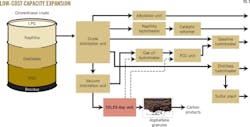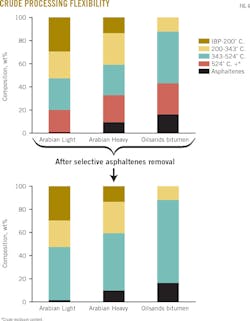Asphaltenes extraction treatment yields advantaged hydroprocessing feedstock
Bo Yuan
Zhifang Tang
Keng H. Chung
North Huajin Chemical Industries Group Corp.
Panjin, China
Qiang Wei
Xuewen Sun
Zhiming Xu
Suoqi Zhao
Chunming Xu
China University of Petroleum
Beijing
Selective extraction of asphaltenes (SELEX-Asp) technology-a solvent-based physical separation process capable of selectively removing asphaltenes as dry granulates in heavy crude oils and petroleum residue-has emerged as an alternative treatment option that could deliver cleaner, higher-quality feedstock immediately usable across multiple processing units (OGJ, Apr. 5, 2010, p. 52).
A series of follow-up tests at existing pilot and commercial-scale units in China concluded that using SELEX-Asp technology instead of traditional processes to pretreat vacuum residua (VR) derived from inferior-quality, heavy crudes also prepares a cost-friendly and environmentally compliant feedstock especially for conventional packed-bed hydroprocessing units. Direct production of this feedstock via SELEX-Asp can further maximize profitability of a refinery's existing bottoms stream as well as eliminate its need to use costlier but less-efficient coking and ebullated-bed reactor systems for feedstock pretreatment.
Background
Heavy crude oils and petroleum residue contain high concentrations of contaminants that must be removed before most refining processes. While common industry practice is to use energy-intensive and costly pretreatment technologies such as coking and ebullated-bed hydroprocessing to remove most contaminants, these processes often require extended unit shutdowns and yield feedstock still unsuited for additional processing in units producing fuels that will meet today's increasingly stringent environmental regulations.1
In conventional refineries, fluid catalytic cracking (FCC) is the key process used to convert heavy distillates (vacuum gas oil) into transportation fuels such as gasoline, jet fuel, and diesel. Packed-bed hydrotreating and hydroprocessing units remove contaminants and enhance feedstock processability before further downstream processing.
Improvements to catalytic refining processes over the past 30 years have enhanced their ability to process heavier feedstock, which typically includes a blend of distillates as well as a certain amount of residua. Many modern refineries are equipped with resid fluid catalytic cracking (RFCC) units and packed-bed resid hydroprocessing units to treat and convert low-cost, heavy feedstock into transportation fuels.
These catalytic processes, however, require stringent feedstock-quality specifications to prevent rapid catalyst deactivation and plugging of packed-bed catalysts.
For RFCC units, Conradson carbon residual (CCR) content of feedstock should not exceed 8 wt%, while total-metals content should not exceed 20 ppm.2 3
Feedstock with excessive CCR or total-metals contents is unsuitable for processing through packed-bed resid hydrocrackers.3 CCR content of feedstock for this type of processing should not exceed 12 wt%, with total-metals content not to exceed 100 ppm.4 5
Even after subjecting heavier feedstock to conventional solvent deasphalting (SDA), the resultant deasphalted oil (DAO) still may be unsuitable for packed-bed resid hydroprocessing. It first must be blended with light crude or a lighter hydrocarbon fraction to sufficiently dilute undesirable contaminants.6
Residuum chemistry
The lack of adequate analytical techniques for characterizing heavy petroleum fractions makes the chemistry of petroleum residuum difficult to define and detailed quantification and correlation of resid feedstock properties to reaction process performance impossible. The use of feedstock specifications (CCR, total-metals contents) as criteria for selecting reactor systems to process various heavy crudes and residua, then, is more intuitive than scientific.3-5
CCR is an indicator of the amount of coke that forms when hydrocarbon samples undergo destructive distillation (OGJ, Jan. 20, 1997, p. 66). Not all CCR species in VR subfractions have the same coking propensity.7
Fig. 1 shows uneven distributions of CCR and metals species in VR.
Except for the CCR content present in petroleum asphaltenes, most CCR species in VR can be converted to noncoke species via hydrotreating and hydrocracking processes.8
Undesirable components concentrated in asphaltenes must be removed before processing remaining VR fractions in conventional refinery RFCCs and packed-bed hydroprocessing units.9-10
SELEX-Asp technology can selectively remove VR subfractions, including asphaltenes (OGJ, Apr. 5, 2010, p. 52) and prepared DAO's with differing amounts of asphaltenes (from trace amounts to 9 wt%), from VR's of different origins. Studies of SELEX DAO-derived asphaltenes using ultrahigh-resolution Fourier transform ion cyclotron resonance mass spectrometry (FT-ICR MS) concluded that their chemistry hinged on asphaltene content resulting from the selective extraction of asphaltene subfractions. Varying solvent extraction powers at critical solvent conditions created the selective extraction.11-12
Packed-bed hydroprocessing
SELEX DAO samples of various asphaltene contents underwent catalytic hydroprocessing screening tests. These tests involved mixing the samples with hydrogen gas and introducing the mixture to a 125-ml continuous catalyst testing unit under mild hydroprocessing conditions.
Designed in a grading-bed configuration, the testing unit contained five types of catalysts:
- Hydrodemetalization (HD metals).
- Hydrodesulfurization (HD sulfur).
- Hydrodenitrogenation (HD nitrogen).
- CCR removal (HD aromatics).
- Mild hydrocracking (MHC).
Results of pressure-drop monitoring across the packed-catalyst bed reactor showed that SELEX DAO with less than 2 wt% asphaltenes had a constant differential pressure across the catalyst bed after an 18-hr continuous run, without any sign of catalyst coking or plugging.
SELEX DAO with higher than 2 wt% asphaltenes showed a 50-kPa differential pressure increase across the catalyst bed after a 7-hr continuous run, indicating possible catalyst coking or plugging.
In an extreme case of SELEX DAO with 9 wt% asphaltenes, the catalyst reactor was plugged after 2 hr of operation, suggesting that SELEX DAO with higher than 2 wt% asphaltenes was not suitable for packed hydroprocessing.
Additional studies
Athabasca oil sands bitumen and Venezuelan Orinoco extra-heavy crude served as worst-case scenarios for subsequent studies to investigate SELEX DAO's suitability as feedstock for packed-bed hydoprocessing units.
Fig. 2 shows the processing steps used to prepare these VRs as feedstock for packed-bed hydroprocessing.
Canadian bitumen
Testing of a bitumen-derived VR obtained from a commercial oil sands plant in Fort McMurray, Alta., occurred at a 1-b/d continuous pilot-scale SELEX-Asp unit at the China State Key Laboratory of Heavy Oil Processing, Beijing.
Adjusting the SELEX-Asp process operating parameters ensured removal of all pentane-insoluble asphaltenes as solid granules and an asphaltene-free VR product.
While the unit removed asphaltenes equivalent to 16 wt% of oilsands bitumen, SELEX DAO still contained 13 wt% CCR and 250 ppm metals, both of which exceed packed-bed resid hydroprocessing specified feedstock-operating guidelines of 12 wt% CCR and 100 ppm metals.
Mixing the SELEX DAO with hydrogen gas occurred before introduction to a 125-ml continuous catalyst testing reactor operated under MHC conditions. The catalyst-testing reactor was a commercial apparatus packed with a guard-bed material and the five types of equilibrium catalysts (HD metals, HD sulfur, HD nitrogen, HD aromatics, and MHC) in a grading-bed configuration.
Feeding the reactor unit continuously for 1,500 hr with a similar-quality feed derived from extra-heavy crude preceded the SELEX DAO's resid-hydroprocessing run, allowing catalysts in the reactor to be at an equilibrium state when the SELEX DAO-hydrogen mixture entered the unit.
The continuous packed-bed hydroprocessing run with SELEX DAO also lasted for 1,500 hr, with no observable sign of pressure drop across the catalyst bed. Results showed no catalyst-bed plugging, even though the SELEX DAO feedstock contained relatively high CCR (13 wt%) and metals (250 ppm) concentrations.
A gas-liquid separator divided the reaction product into gas and hydroprocessed liquid that were sampled for analysis daily.
The accompanying table shows the properties of bitumen-derived VR before and after SELEX-Asp treatment as well as SELEX DAO products' properties following MHC.
Test run results showed a dramatic improvement in the properties of bitumen-derived VRs following SELEX-Asp treatment and subsequent packed-bed hydroprocessing of SELEX DAO, including a yield of 10 wt% diesel and 40 wt% heavy gas oil (HGO) based on simulated distillation.
SELEX DAO also yielded a much lighter reaction liquid following MHC (Fig. 3).
Most importantly, the reaction liquid product contained 4 wt% CCR, 3 ppm metals, and 45 wt% saturated hydrocarbons, all of which are characteristics of superior catalytic cracking feedstock.
Venezuelan Orinoco
A separate investigation tested SELEX DAO derived from extra-heavy Orinoco crude obtained from PetroChina's refinery near Liaohe oil field, which is equipped with a commercial-scale SELEX-Asp unit (OGJ, Apr. 5, 2010, p. 52).
This study adjusted SELEX-Asp operating parameters to yield SELEX DAO containing 1.3 wt% pentane-insoluble asphaltenes as well as high concentrations of CCR (13.5 wt%) and metals (280 ppm). Ultrahigh-resolution FT ICR-MS analysis showed that SELEX DAO asphaltene (1.3 wt%) chemistry was not the same as typical DAO asphaltenes derived from conventional SDA processes, likely because a liquid-liquid extraction SDA system made the entrained DAO asphaltenes nonselective. SDA DAO asphaltenes have an established history of causing catalyst coking and plugging of packed-catalyst beds.
The Orinoco-derived SELEX DAO ran through the same 125-ml continuous catalyst testing reactor after being mixed with hydrogen gas. The unit operated under MHC conditions and was packed with a guard-bed material as well as the five fresh catalysts (HD metals, HD sulfur, HD nitrogen, HD aromatics, and MHC) in a grading-bed configuration.
Before resid-hydroprocessing the reactor unit went through presulfiding with 2% carbon disulfide in cyclohexane for 72 hr, followed by precoking with VGO derived from Chinese Daqing crude for 48 hr. The continuous packed-bed resid hydroprocessing run with SELEX DAO took 1,300 hr.
The resid hydroprocessing run varied both the operating pressure and liquid hourly space velocity (LHSV), with the temperature kept constant.
Fig. 4 shows the online process performance data and concentrations of CCR and metals from the run's daily reaction product samples.
The reactor ran at base pressure for its first 500 hr, later increased to base +4 MPa pressure. Test results showed relatively constant reactor pressure, with no pressure-drop build-up observed across the catalyst bed for the run's duration.
Removal of CCR and metals depended on reaction severity, with high reaction severity (high pressure and low LHSV) increasing removal.
The slopes of CCR and metals concentrations of daily reaction products showed high-reaction pressure reducing the catalyst deactivation rate. Results generally verified that even though SELEX DAO is a heavier feedstock, it performs similarly to VGO during resid hydroprocessing.
Results overview
The catalyst systems used in both tests were not optimized and commercial packed-bed residuum desulfurization (RDS) unit specifications for processing "cleaner" feedstock (containing less than 12 wt% CCR and 100 ppm metals) provided the basis for selecting mild hydroprocessing conditions for continuous pilot testing of SELEX DAOs.5 RDS units, however, require replacement of HD metals catalyst after 3-4 months of service due to coking and bed plugging.
SELEX DAOs containing higher concentrations of CCR and metals, however, showed no signs of pressure-drop build-up across the catalyst bed after more than 2 months of operation. Moreover, if catalyst coking and bed plugging had occurred, pressure-drop build-ups across the packed-catalyst bed likely would have been more severe in a pilot-scale reactor system than a commercial-scale system. The studies demonstrated that SELEX DAO perform better and more economically than traditionally derived VRs as feedstock for packed-bed hydroprocessing as a result of the longer catalyst-service cycle.
Results also confirmed that conventional packed-bed resid hydroprocessing of VR's derived from SELEX-Asp pretreatment further increases the volume and quality of potential feedstock suitable for other refinery processes downstream of the hydroprocessor, eliminating the need to use coking or ebullated-bed reactor systems for feedstock pretreatment.
Results also pointed to the need to revise currently less-than-sophisticated feedstock-specification guidelines used by the industry to select reactor systems,2-5 incorporating actual feedstock-characterization data obtained from advanced analytical techniques.11
Applications
It is common practice in the refining industry to design and construct a processing unit 10-15% larger than its planned operating capacity. This additional capacity, in most cases, is not used.
The studies discussed in this article offer further evidence that adding a commercial-scale SELEX-Asp unit at a typical conventional refinery (Fig. 5), such as North Huajin Chemical Industries Group Corp.'s in Panjin, creates a low-cost and simple means of expanding its overall operating and production capacities.
VRs and bottom streams such as fuel oil that otherwise would be discarded now serve as feedstock for SELEX-Asp treatment to produce feedstock for further processing. Since processability of SELEX-DAO mirrors that of VGO, the refinery can capitalize on spare capacity of existing units (gas oil hydrotreater, RFCC) to process SELEX-DAO and increase yields of more valuable fuel streams without having to purchase additional feedstock.
With only a small amount of low-value solid asphaltenes left over, disposal costs also are minimized.
Refinery flexibility
The studies discussed in this article also confirmed SELEX-Asp's ability to expand a refinery's flexibility to process unconventional heavy crudes more economically by averting the need to use costlier cokers and ebullated-bed reactor systems to pretreat the more contaminated cuts derived from these crudes.
Fig. 6 shows the compositions of benchmark crudes Arabian Light (36° API gravity), Arabian Heavy (26° API gravity), and oil sands bitumen (8° API gravity), before and after SELEX-Asp treatment.
As a crude gets heavier, its residuum content (524° C.+ fraction) increases. For untreated crudes, the amount of native residua (shown in red) varies slightly. The amount of asphaltenes (shown in black), however, differ sharply (1 wt% Arabian Light, 9.5 wt% Arabian Heavy, and 16 wt% oil sands bitumen), highlighting asphaltene removal as the key problem of residuum processing.
Benchmark crudes treated by SELEX-Asp technology in ongoing tests have shown removal of residua contaminants sharply increases the amount of VGO (shown in blue) feedstock that is well-prepared for further downstream processing.
At current global crude-consumption rates of 95 million b/d, the authors estimate SELEX-Asp processing technology could provide conventional refineries an additional 5 million b/d of feedstock for production of cleaner fuels.
References
1. Chung, K.H., Xu, Z., Sun, X., Zhao, S., and Xu, C., "Selective asphaltene removal from heavy oil," PTQ, Fourth Quarter 2006, p. 99.
2. Motaghi, M., Subramanian, A., and Ulrich, B., "Slurry-phase hydrocracking-possible solution to refining margins," Hydrocarbon Processing, Feb. 1, 2011, pp. 37-43.
3. Zuo, L., "Present situation and prospect for FCC technology development in China," Technology-Economics in Petrochemicals, Sinopec Technology and Economic Information Center, Vol. 16, No. 1, 2000, pp. 16-21.
4. Dai, L., Hu, Y., and Li, J., "Activity evaluation of residue hydotreating cayalyst during commercial running and its remaining life prediction," Petroleum Processing and Petrochemicals, Vol. 31, No. 12, 2000, pp. 13-16.
5. de Haan, D. Street, M., and Orzeszko, G., "New residue-upgrading complex achieves Euro 5 specifications," Hydrocarbon Processing, Feb. 1, 2013, pp. 41-44.
6. Threlkel, R., Dillon, C., Singh, U.G., and Ziebarth, M.S., "Increase the flexibility to upgrade residuum using recent advances in RDS/VRDS-RFCC process and catalyst technology," 24th Japan Petroleum Institute International Symposium, Nov. 5-7, 2008.
7. Chung, K.H., Xu, C., Gray, M., Zhao, Y., Kotlyar L., and Sparks, B., "The Chemistry, Reactivity, and Processability of Athabasca Bitumen Pitch," Reviews in Process Chemistry and Engineering, Vol. 1, 1998, pp. 41-79.
8. Chung, K.H., and Xu, C., "Narrow-cut characterization reveals resid processing chemistry," Fuel, Vol. 80, No. 8, 2001, p. 1165.
9. Gray, M.R., Zhao, Y., McKnight, C.M., Komar, D.A., and Carruthers, J.D., "Coking of hydroprocessing catalysts by resdiue fractions of bitumen," Energy & Fuel, 1999, Vol. 13, p. 1037
10. Yang, C., Du, F., Zheng, H., and Chung, K.H., "Hydroconversion characteristics and kinetics of residue narrow fractions," Fuel, Vol. 84, No. 6, 2005, pp. 675-684.
11. Zhang,Y., Zhang, L., Xu, Z., Zhang, N., Chung, K.H., Zhao, S., Xu, C., and Shi, Q., "Molecular characterization of vacuum resid and its fractions by Fourier transform ion cyclotron resonance mass spectrometry with various ionization techniques," Energy Fuels, Vol. 28, 2014, pp. 7448-7456.
12. Zhao, S., Wei, Q., Xu, C, Xu, Z., Sun, X., and Chung, K.H., "A method of processing heavy oils and residua," US Patent Application No. 15/054, 959; Canadian Patent Application No. 2,920,054; China Patent Application No. 201510290167.0.
The authors
Bo Yuan ([email protected]) is director of Technology Research and Development Centre at North Huajin Chemicals Industries Group Corp. He has held various senior technical and executive positions in petrochemical operations for 30 years. He holds a BS in chemical technology from Dalian University of Science and Technology, China.
Zhifang Tang ([email protected]) is chief engineer and board director at North Huajin Chemicals Industries Group Corp. Ltd. He previously held senior technical and executive positions with PetroChina Fushun Petrochemical Co. Ltd. With more than 30 years of refinery and ethylene production experience, Tang holds a BS in petrochemical engineering from Fushun Petroleum Institute, China.
Keng H. Chung ([email protected]) serves as refinery advisor for North Huajin Chemical Industries Group Corp. He also acts as a process troubleshooting expert for petroleum operations and actively is involved in developing sustainable heavy oil technologies. Chung holds a BS and MS in chemical engineering from Queen's University, Kingston, Ont., and a PhD in chemical and petroleum engineering from the University of Calgary. He is a registered professional engineer in Alberta.
Qian Wei ([email protected]) is an associate professor and research scientist at China University of Petroleum, Beijing. He was a visiting scholar at Natural Resources Canada's CANMET Western Research center at Devon, south of Edmonton, Alta. He specializes in hydroprocessing and desulfurization catalysis. Wei holds a BS from Shandong University and an MS and PhD from China University of Petroleum, all in chemical engineering.
Xuewen Sun ([email protected]) is an associate professor at China University of Petroleum and a senior scientist at China State Key Laboratory of Heavy Oil Processing. He specializes in heavy oil processing technology, petrochemicals, and supercritical fluid extraction. Sun holds a BS from Daqing Petroleum College and a PhD from China University of Petroleum, all in chemical engineering.
Zhiming Xu ([email protected]) is an associate professor at China University of Petroleum and a senior scientist at China State Key Laboratory of Heavy Oil Processing. He was a visiting scholar at Canada National Research Council, Ottawa. Xu specializes in heavy oil chemistry and processing technology and supercritical fluid extraction. He holds a BS and MS in chemical engineering from China University of Petroleum.
Suoqi Zhao ([email protected]) is a professor at China University of Petroleum, Beijing and a deputy director at China State Key Laboratory of Heavy Oil Processing. He was a visiting scholar at Canada National Research Council, Ottawa. Zhao specializes in heavy oil chemistry and supercritical fluid technology. He holds a BS and PhD in chemical engineering, both from China University of Petroleum.
Chunming Xu ([email protected]) is a vice-president and professor at China University of Petroleum and also serves as a deputy advisory chair at China State Key Laboratory of Heavy Oil Processing. Xu was a visiting scholar at Syncrude Research Center, Edmonton. His research interests include heavy oil chemistry and processing technology. Xu holds a BS, MS, and PhD in chemical engineering, all from China University of Petroleum.
